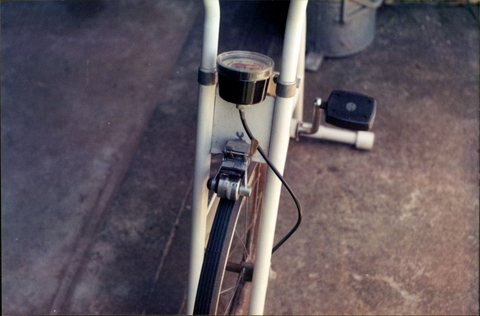Early on I tried several ideas here but only one with any degree of success. The first method has direct connection to the power grid via a battery charger…..hardly self sufficient but it helped me test the system before I could come up with anything more sustainable. The second was a 12 volt petrol generator that I build based on a car alternator and motor mower engine, for obvious reasons this was also a flop!
The third idea was a SolarexX44 BG photovoltaic panel, which cost $351 about 25 years ago (it is based on the old round solar cells). It is rated to produce 1.35 amps but on a good summers day will hit 1.8 amps, and after 25 years it is still in place and there has been no loss of output, damn, that’s good! Day after day, year after year, without smoke, fumes or noise it continues to pump electricity into a third generation of batteries that it has powered, appropriate technology at its best.

About 17 years ago I added a BP Solar Panel to the system which gives a peak output of about 2.5 amps (Sorry I can’t be more technical here, the specs went west long ago) and likewise it is still going strong. ten years ago I saved up my pennies and added a third solar panel, a Photowatt International PW 750 which on a good day can pump out 4 amps which about doubles my generation capacity. It cost a bit at $600 but was the best cost per watt unit that I could afford. All of these units continue to pump electricity into my batteries whenever there is light shining on them, they require little maintenance, don’t annoy the neighbours and have no on-going costs associated with them.
The latest addition has been 4 x 80 watt Solarex panels, donated by my brother – or at least on loan – I can now charge up to 25 amps – a huge boost to the system. After wiring everything up and connecting to the ammeter I got a maximum charge of only 16 amps. After checking everything and much hassle, it turned out that the ammeter itself was faulty and required changing – bugger!
I did some work about 20 years ago on a bicycle based wind generator. It was a bicycle wheel, forks and head set, with metal over the spokes and a roller style bicycle generator. After being a local landmark (and eyesore) for a number of years it finally bit the dust about 15 years ago. It proved to be all that the photovoltaics were not: it was not attractive, gave off a noise in high winds that did annoy the neighbours, required frequent maintenance and at full belt delivered less that an amp to the system. It was just not practical, even if it was home made from recycled parts.
The lure of the wind generator is strong. However! I always wanted to make my own, hand crafted and based on a car alternator, but with so many projects I never go the time. In early 2005, there were some Chinese wind generators doing the rounds, producing around 200 watts at 12 volts, the kit was self contained but the whole thing weighed 70kg, add wind load to that and it was a substantial amount of kit to mount on the garage. It was also comparatively large with a blade diameter of 2.5 metres. I figured I better get council approval (it was a bit difficult to hide!) and after the obligatory 1 minutes silence for weirdo identification the told me that inspections etc would cost over $300 which added considerably to the original $450 price tag. In the end I shelved the idea after concerns about the weight as well as council hassles.

As I said above, the lure of wind generators is strong and while overseas I saw some much smaller and less obtrusive units. After research back in Aus I found the AirX 400 watt 12 volt wind turbine. It was double the cost of the Chinese unit but it was twice the power, only had a blade diameter of 1.17 metres and weighed 6.5kg, it was about as obtrusive as your average TV aerial! Needless to say it is now installed on the side of the garage and affords me endless pleasure (and power) as I watch it rotating in the wind while working in the garden. No I haven’t mentioned it to council, we’ll see how we go.

A recent experiment was to connect the old bicycle wheel generator to a small exercise bike, which we bought second hand to fight the problem that I have had with shrinking clothes recently. This also was not a real success due to the lack of output. I did toy around with the use of a car alternator but the challenge was to develop a gearing system that would allow the alternator to turn fast enough to generate meaningful power without inducing apoplexy in the “operator”. Clearly there is some work still to be done here.



